According to various purposes, functions and uses, tents are divided into different types with different sizes. If you want to buy or sell tents, you should be clear about different types of tents with various features.
This article lists 16 types of tents with pictures to help you have a better understanding of tents and we hope you can always choose the right tent if you need it.
Tent Parts You Should Know Before Choosing a Tent
Tents are made up of different parts with different styles. This part will introduce the main parts and features of a tent. When you choose a tent, you can consider these factors to make a suitable decision.
Different tents have different structures, so their shapes are different as well. Each tent has several basic components, including the following parts.
Cover Cloth
Cover cloth is the main part of a tent, and there are many different materials and fabrics used for making tent cloth, you can find more information in another article about tent materials on our website.
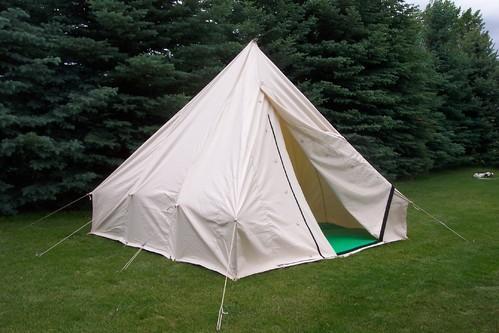
Tent Poles
Tent poles are used to provide support for the whole tent, usually including two types, rigid tent poles and bendy tent poles. Rigid ones are firmer and heavier; bendy ones are more flexible and lighter. Different materials decide the price and weight of tent poles.
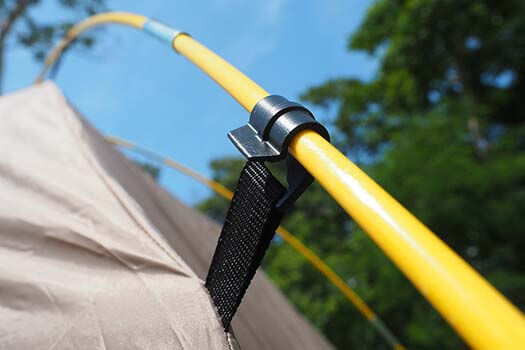
Air Tubes
Air tubes are another creative form of tent poles. Some types of tents choose this kind of non-pole structure.
Compared to traditional tent poles, air tubes are more convenient for carrying, easy to assemble and disassemble, saving time and energy. You don’t need to worry that it would break in bad weather, because it is quite safe.
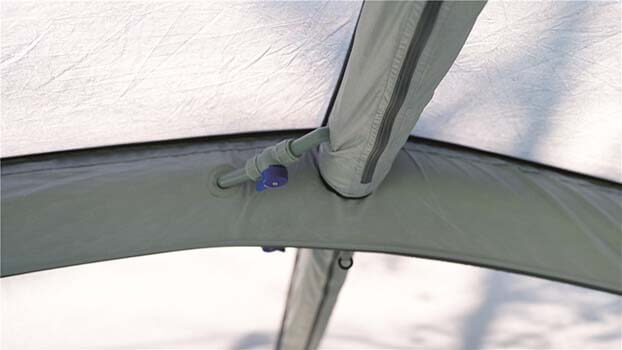
Groundsheets
Groundsheets are usually put inside the tent to provide moisture protection and dust prevention. Most of them are not waterproof, so you need other equipment, like sleeping bags to use when you sleep.

Guy Ropes and Pegs
Guy ropes and pegs are used to fix the whole tent for keeping balance and preventing it from moving away. Pegs have different sizes and shapes suitable for pegging in different textures of ground. It is connected with various wind and ground conditions as well as equipped standby ones.
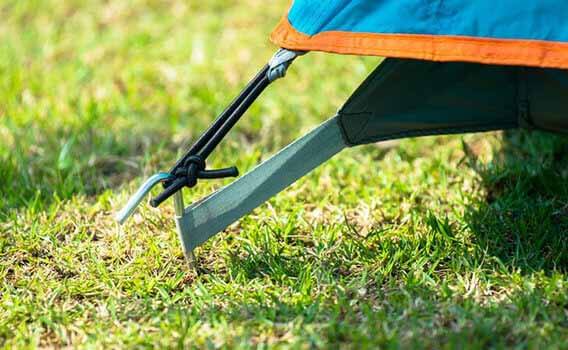
Image from planetware.com
6 Factors to Consider When Choosing a Tent
After knowing the basic parts of a tent, you should know what factors of a tent you need to consider when you choose a tent. Here lists these factors for your reference.
- Tent purpose: This is the base for you to choose a tent. According to your using purpose, you choose a kind of tent properly.
- Using season of tent: Some tents can be used in 4 seasons, in 3 seasons or only in summer or winter. According to the seasonal temperature, the thickness of tents is required differently.
- Tent capacity: According to your purpose, tents in different sizes can accommodate different numbers of people. You need to consider the tent capacity according to your real demand.
- Tent height: This is also relevant to the space of the tent. Suitable height will make you feel comfortable when staying inside the tent. But it is based on the height of the users.
- Tent style: For some special usages, tent styles should be considered as well. If you have additional requirements on styles, you check more patterns to find your favorite one.
- Windows: The function of windows is to increase ventilation in a tent. Usually, large tents are equipped with designed windows.
1. Tent purpose
This is the base for you to choose a tent. According to your using purpose, you choose a kind of tent properly.
2. Using season of tent
Some tents can be used in 4 seasons, in 3 seasons or only in summer or winter. According to the seasonal temperature, the thickness of tents is required differently.
3. Tent capacity
According to your purpose, tents in different sizes can accommodate different numbers of people. You need to consider the tent capacity according to your real demand.
4. Tent height
This is also relevant to the space of the tent. Suitable height will make you feel comfortable when staying inside the tent. But it is based on the height of the users.
5. Tent style
For some special usages, tent styles should be considered as well. If you have additional requirements on styles, you check more patterns to find your favorite one.
6. Windows
The function of windows is to increase ventilation in a tent. Usually, large tents are equipped with designed windows.
16 Types of Tent
According to various styles and shapes, use purposes and occasions, there are different types of the tent for events. This part will introduce several common types of tent used widely in daily life, listing these tent names with pictures.
When you want to go close to nature, camping is a good way to realize. So in this activity, camping tents are the necessary equipment for you to enjoy nature.
The camping tent is the most widely used in all types of tent. It has many classifications in different styles, shapes and sizes. Every type of camping tent has different tent names. Here mainly lists common types of camping tents for your reference.
1. Dome Tent
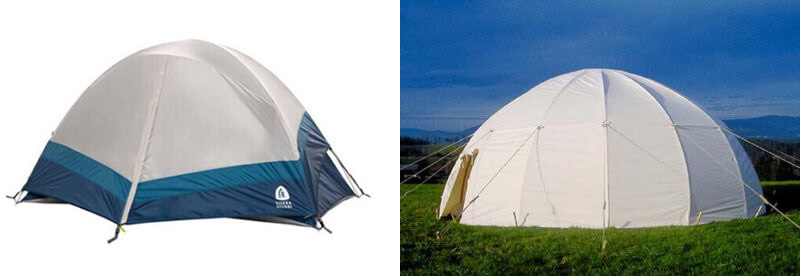
This type of tent is the most common one among camping tents at present. Simply, the dome tent has two poles or more poles crossing with each other from a corner to the opposite corner, providing support for the whole tent. The basic shape of a dome tent is similar to a semicircle.
Pros
- The shape is designed for use in a gale or severe weather.
- Have developed many shapes with different functions.
- The price is not a single standard but varies from materials and size.
- It is good in cost performance.
Cons
- It has just a single room, so it is a sharing place, with less privacy.
pros
- The shape is designed for use in a gale or severe weather.
- Have developed many shapes of the tent with different functions.
- The price is not a single standard but varies from materials and sizes.
- It is good in cost performance.
Cons
- It has just a single room, so it is a sharing place, with less privacy.
2. Tunnel Tent

The tunnel tent is usually made up of two or more poles with the connection of tent cloth. The tunnel is supported by the poles to form several rooms with enough space at the same height.
Pros
- It has different styles and sizes, so its price has no single standard.
- The size is usually larger than other single tents.
- Suitable for more than 2 people or family camping activity.
Cons
- Need to pay attention to the wind direction when building it.
- If set in the wrong direction, it is easy to be blown down by the wind.
- The process of setting up is not easy, more like a tent of the compound style.
pros
- It has different styles and sizes, so its price has no single standard.
- The size of tunnel tents is usually larger than other single tents.
- Suitable for accommodating more than two people or family camping activity.
Cons
- Need to pay attention to the wind direction when building it.
- If it is set in the wrong direction, it is easy to be blown down by the wind.
- The process of building the tent is not easy, more like a tent of the compound style.
3. Ridge Tent

Ridge tent is a traditional tent with a long history. Its structure is very simple, just like a triangle or mountain top. It is made up of poles at both ends to support a roof of the tent like the ridge. It can be a large tent for glamping activities.
Pros
- It is very stable and easy to build up.
- It has a variable size from small to large rooms.
Cons
- The tent top is narrow, even though the whole tent is high.
- The material and fabric is usually cotton canvas, very heavy.
pros
- It is very stable and easy to build up.
- It has a variable size from small to large rooms.
Cons
- The structural disadvantage is the tent top is narrow, even the whole tent is high.
- The material and fabric of the ridge tent is usually cotton canvas, very heavy.
4. Teepee Tent
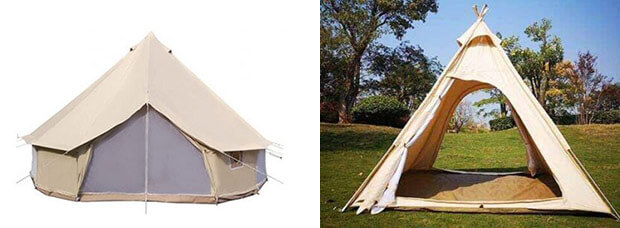
Teepee tent was called tipi in the past, which was a tent with the shape of a triangle, made of animals’ skin. It’s used for camping as well. But later, for the reason that it’s not easy to carry and not practical, it has been replaced by other tents.
Many teepee tents are heavy and influenced easily by weather. Modern teepee tents have changed styles and sizes, used widely by children in small sizes, and used for glamping activities in large sizes.
Pros
- Small size, suitable for children
- Good performance in decoration
- Easy to put up
Cons
- Heavy, not portable
- Limited by many conditions, like weather, ground
pros
- Small size, suitable for children
- Good performance in decoration
- Easy to put up
Cons
- Heavy, not portable
- Limited by many conditions, like weather, ground
5. Roof Top Tent/ Car-Top Tent

Rooftop tent, also car-top tent is a new form of the camping tent. The tent is installed on the top of vehicles; hence the name is called roof top tents or car-top tents.
Pros
- These top tents are camping tents for professional campers.
- It can be used in any place.
- Avoid unsmooth ground
- Keep wild animals away.
Cons
- The installment on the vehicle is not simple.
- It requires a ladder to enter.
- Users may fall off from the tent.
- It cannot resist bad weather well.
- Its flexibility is not ideal.
- It is expensive in most cases.
pros
- These top tents are camping tents for professional campers.
- It can use in any place, avoid the unsmooth ground and keep wild animals away.
Cons
- The installment of the tent on the vehicle is not simple and requires a ladder to enter.
- Users may fall off from the tent.
- It cannot resist bad weather well and its flexibility is not ideal.
- The price of this kind of type is expensive in most cases.
6. Inflatable Tent
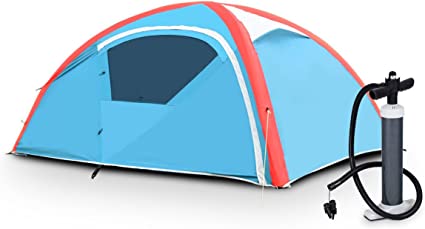
The inflatable tent has no sturdy poles to provide support. Its support structure is the air tubes. This is a new style of tent. It can make many new beginners set up a tent easily. The shapes and styles of the inflatable tent are various. The air beams of it are the most distinctive feature.
Pros
- Friendly to new beginners and easy to set up
- Saving time and energy
- Without sturdy tent poles, easy to carry
Cons
- The inflator pump is a must.
- If anywhere is leaky, the whole tent cannot be useful.
- More expensive
pros
- Friendly to new beginners and easy to set up
- Saving time and energy
- Without sturdy tent poles, easy to carry
Cons
- The inflator pump is a must.
- If anywhere is leaky, the whole tent cannot be useful.
- More expensive
7. Pop up tent
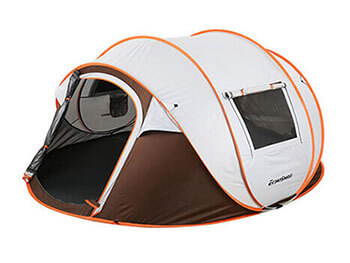
Pop up tent is a kind of simple tent. It doesn’t need users to set up but just open it and the tent would pop into the final shape just in a few seconds.
Pros
- Light, small and portable
- Saving time and energy
- Very easy to set up
Cons
- Limited space, providing less space for sleeping
- Not wind-proof
- Taking more time to fold it up like the beginning
pros
- Light, small and portable
- Saving time and energy
- Very easy to set up
Cons
- Limited space, providing less space for sleeping
- Not wind-proof
- Taking more time to fold it up like the beginning
8. Backpacking Tent/Mountain Tent
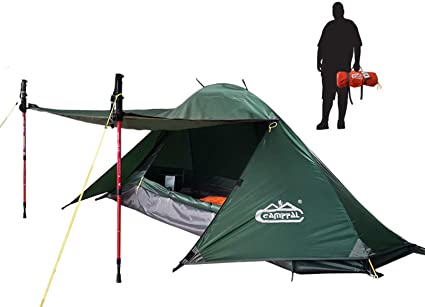
A backpacking tent is a new form of a tent for camping or climbing. It is preferred by backpackers more. It has many styles and shapes for different demands. The most distinctive feature is its small size without occupying too much space and easy to carry.
Pros
- Light, small, occupying less space
- Convenient, portable
- Easy to set up
Cons
- Providing less space for sleeping or moving
- Only for 1 or 2 people to use
- Special design for professional activities, more expensive
pros
- Light, small, occupying less space
- Convenient, portable
- Easy to set up
Cons
- Providing less space for sleeping or moving
- Only for 1 or 2 people to use
- Special design for professional activities, more expensive than common tents
9. Geodesic Tent/ Semi-Geodesic Tent
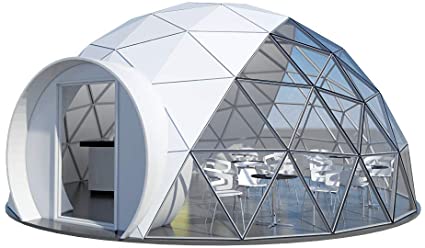
Geodesic Tents, also semi-geodesic tents are a special kind of camping tent. The difference from the common camping tents is that their constructions are more complicated with more tent poles in the shape of many-sided figures.
Pros
- Remain stable to resist bad weather, like stormy or snowy weather
- Sturdy enough with many tent poles to support
- Enough space for accommodating
Cons
- Not easy to set up
- More expensive
- Heavy, not portable
pros
- Remain stable to resist bad weather, like stormy or snowy weather
- Sturdy enough with many tent poles to support
- Enough space for accommodating
Cons
- Not easy to set up
- More expensive
- Heavy, not portable
10. Suspended Tent
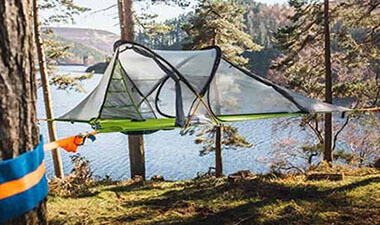
The suspended tent combines the feature of the hammock. It can hang in the air like a hammock. But better than the hammock, it has a tent cloth to cover users.
Pros
- Light, portable
- Don’t need sleeping bags anymore
- Easy to set up, saving time and energy
Cons
- Only used in forests or with poles to tie ropes, limited by places
- Narrow space, only for children or one person
- Poor performance in resisting bad weather
pros
- Light, portable
- Don’t need sleeping bags anymore
- Easy to set up, saving time and energy
Cons
- Only used in forests or with poles to tie ropes, limited by places
- Narrow space, only for children or one person
- Poor performance in resisting bad weather
11. Bivy Tent
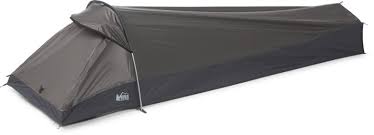
The bivy tent combines the functions of a tent and a sleeping shack. Users can sleep in this tent without extra sleeping bags.
Pros
- Convenient, portable and practical
- Good air tightness
- It can be used in any place.
Cons
- Narrow space, only for one person mostly
- The appearance is not very good
- It would be easily influenced by weather
pros
- Convenient, portable and practical
- Good air tightness
- It can be used in any place
Cons
- Narrow space, only for one person mostly
- The appearance is not very good
- It would be easily influenced by weather
12. Beach Tent
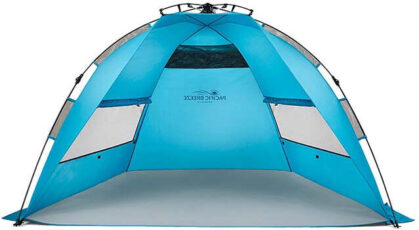
The beach tent is usually different from the camping tents mentioned above. It is specially used for activities on the beach. So it is not very thick or moisture-proof enough. People use it for taking a break or sunshade, and the window or door of the tent is not necessary.
Pros
- Used for sunshade or sun block
- Light, portable
- UV protection
Cons
- Not very thick
- Easy to be blown away
·Not suitable for sleeping
pros
- Used for sunshade or sun block
- Light, portable
- UV protection
Cons
- Not very thick
- Easy to be blown away
- Not suitable for sleeping
13. Bubble Tent

The bubble tent is transparent and visible. Its shape is like a bubble. It is more suitable for family activities or glamping activities.
Pros
- Beautiful, decorative
- Large space for accommodating many people
- Interesting
Cons
- Not easy to set up
- Heavy and not portable
- More expensive than common tents
- Not practical in most camping activities, limited by places
pros
- Beautiful, decorative
- Large space for accommodating many people
- Interesting
Cons
- Not easy to set up
- Heavy and not portable
- More expensive than common tents
- Not practical in most camping activities, limited by places
14. Shower Tent
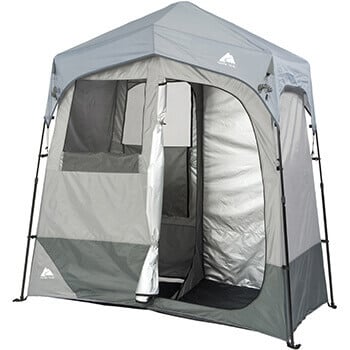
The shower tent is a kind of function tent used in the wild or camping activities. It is not used for sleeping or living, but used for a shower or changing your clothes inside.
- Its height is close to the height of people.
- Its space is only suitable for standing but not for sleeping.
- It needs setting up like the common camping tents.
- It provides convenience for your daily needs.
Except for the different types of tents for camping or other outdoor activities, there are other kinds of tents used in special ways. This part lists two types of special tents for your reference. In most cases, these two types of tent are canopy or frame tents, different from common camping tents.
15. Relief Tent
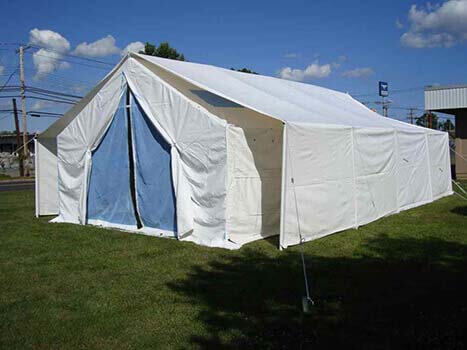
The relief tent is a kind of frame tent. It is specially used for resettling people or refugees after severe disasters, usually in emergency circumstances. So it should be easy to set up.
- Its size is large for accommodating more people.
- It has sturdy tent poles, like steel poles to provide enough support.
- It is waterproof.
- It is convenient for passing in and out like a simple but real house.
- It can stand up to bad weather.
16. Medical Tent
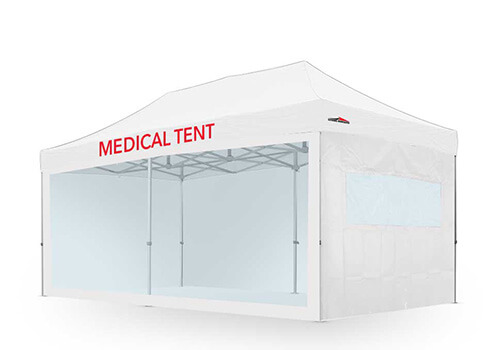
Medical tents are similar to relief tents in the shape, but the outside style may not be the same. Medical tents are used for medical activities outside the hospital, like epidemic prevention work.
- It is transparent and visible on one or two sides.
- It needs to be totally-enclosed or semi-closed to be sterile.
- It requires sanitary conditions at a high level.
- It can accommodate a certain number of people.
- It is sturdy enough.
The End
We hope this article helps you find and choose a tent better when you struggle to choose a tent.
If you want to know more about tents, you can visit our website to find more articles:
We’re Jingsourcing, a leading sourcing agent in China. If you want to import tent or customize tent products from China, please CONTACT US without hesitation!


Leave A Comment